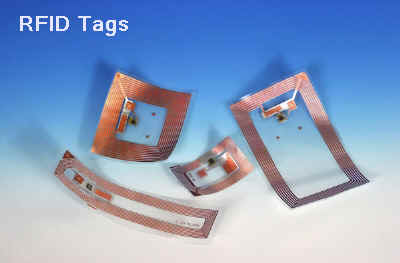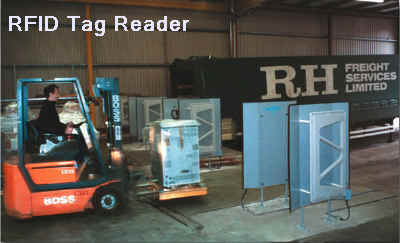While RFID is viewed eagerly by some as a replacement for or physical extension of barcodes - the extra inches/feet representing additional flexibility in implementing ever more efficient processes - for others it is the extension of the technology into new application areas that is generating the excitement. First let's set the context.
Typical RFID systems are composed of two main elements: 1) An RFID
"tag"
(essentially a microchip for information storage and an antenna) [See
Figure 1], and 2)
An RFID reader or "interrogator", which can be fixed or handheld [See
Figure 2].
The tag stores at a minimum a unique ID number and other (usually
static)
information such as origination information. For the most typical
"inductive" systems, the reader transmits a low-power radio signal
through
its antenna that the tag receives via its own antenna. The tag
uses
the energy it gets from the radio signal to transmit the data to the
reader,
which in turn is linked to other system(s) for application
processing.
More advanced (and expensive) tags incorporate battery power (often
called
radiating systems) to increase functionally but have tradeoffs such as
reduced shelf life. RFID systems are deployed across a wide
number
of frequencies, including 125 kHz to 148 kHz, 13.56 MHz, 433 MHz, 915
MHz
and 2.45 GHz. Each has its own advantages and disadvantages and
is
better suited to some applications than others. The cost of these
tags varies greatly, from around 50 cents per tag up towards $100;
readers
generally cost some hundreds of dollars.

Figure 1

Figure 2
The applications that have been enabled by this technology include:
- Transportation/Trucking (Rail, long-haul trucking, short-distance hauling, service station credit transactions, highway toll tags, fleet management in/out tracking, mass transit ticketing)
- Industrial Supply Chain (High cost/rigorous assembly line processing, container ID/tracking, tool/mobile machine management)
- Retail and Distribution (Inventory management, parcel and postal tracking)
- Animal Identification (Livestock/pet identification/tracking and management, forwards and backward tracking)
- Security and Access Control (Human and high value asset monitoring and tracking, building/facility access control, membership card/prepaid car/registration/employee ID card management and counterfeiting protection, computer system access and usage control and component management, medical supply/specimen protection, branded goods replication prevention, library and rental good management, baggage handling, stolen item recovery)
- Power - Does the tag contain a built-in power source or can it only be "passively" activated by the field emitted by the reader? Most systems currently are passive (inductive) in nature - both for historical cost considerations and due to passive systems being sufficient for many of the most traditional applications.
- Read Range - Since most RFID tags are passive, the range of most tags is very limited (usually just a few feet, and often just a few inches). This in turn limits the utility of applications to those where the assets, merchandise, person, or animal must be in close proximity to a reader. Some newer technologies have ranges as high as 20 to 30 feet but have tradeoffs in size and cost. Key factors determining range include antenna size (both tag and reader) and reader output power.
- Storage Capacity - The lowest cost chips have a limited amount of storage capacity and that is read-only. However, RFID technology advancements have increased the capacity and enabled the ability to read/write numerous times in the equivalent amount of space, with storage capabilities now reaching up to 64K, opening up RFID to a variety of more dynamic applications.
- Privacy - The movement of RFID technology into applications serving or targeted at the individual consumer has alarmed many privacy advocates, both with respect to the potential of eavesdropping but more particularly that many of these applications collect or generate data that could be used to abuse an individual's privacy. A lack of technology standards increases these concerns.
- Integration - Applications on the horizon could integrate RFID with other location-related capabilities to deliver exciting new "hybrid" functionality. One example is having an RFID chip implanted or attached to a livestock animal that also has a GPS transponder attached, such that it can be tracked as it moves from its breeding herd to fattening to distribution and processing. This will give the beef industry the capability to both track the (relatively slow) evolution of the animal it moves from one "state" or facility to another (via the RFID readers) and also quickly find a specific animal if the need arises (e.g.a mad cow disease outbreak). A similar system for identifying and locating lost pets would likely find an eager market; current RFID-only devices are only good if the dog has already been found and turned over to an animal shelter that happens to have a reader. For humans, an attached or implanted RFID device combined with a hidden GPS transponder (via a watch, necklace, shoe implant, or other human accessory) could provide a level of unmatched security against kidnapping or accident, or even terrorism. Readers within a facility would ensure that only authorized people are present, with a higher degree of confidence than comes with access cards and employee badges that can be counterfeited. High-risk individuals could be monitored outside the facility to ensure their safety. Children could be closely monitored inside and outside of school. Note: While location-enabled cell phones and other devices will provide some of this kind of functionality, if the phone is lost, stolen, destroyed, or the battery is dead that protection evaporates. Other functionality could be built into these hybrid systems to provide additional security and non-security related services. Of course, privacy protections for these kinds of applications will be particularly important to develop and manage.
Bottom line: RFID technology is enabling a wide variety
of exciting applications and has the potential for enabling many more.
With location playing an increasingly important role in the
functionality
and market attractiveness of these applications, Location professionals
have the opportunity to lead their companies or agencies in
capitalizing
on this technology.
David H.Williams is CEO of E911-LBS Consulting, a consultancy
focused
on helping businesses and government agencies harness the power of
wireless
location. He publishes an online newsletter on various
location-related
industries at www.e911-lbs.com, and can be emailed at
dwilliams@e911-lbs.com.